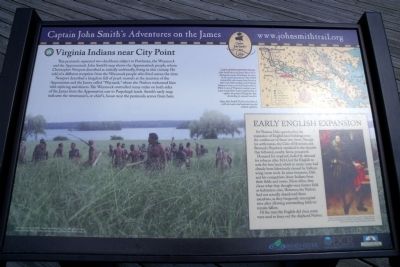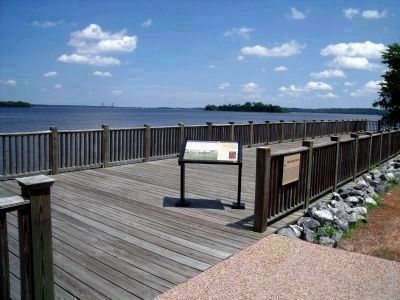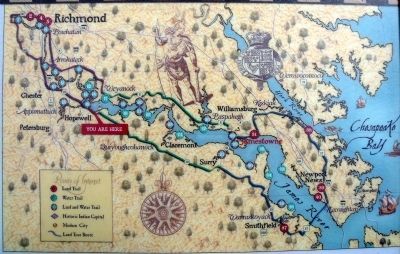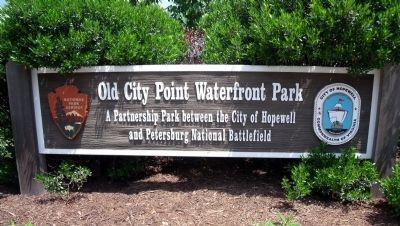Hopewell, Virginia — The American South (Mid-Atlantic)
Virginia Indians near City Point
Captain John Smith’s Adventures on the James
— www.johnsmithtrail.org —
This peninsula separated two chiefdoms subject to Powhatan, the Weyanock and the Appomattuck. John Smith's map shows the Appomattuck people, whom Christopher Newport described as initially unfriendly, living in this vicinity. He told of a different reception from the Weyanock people who lived across the river.
Newport described a kingdom full of pearl-mussels at the junction of the Appomattox and the James called “Waynauk,” where the Natives welcomed him with rejoicing and dances. The Weyanock controlled many miles on both sides of the James from the Appomattox east to Paspahegh lands. Smith's early map indicates the werowance's, or chief's, house near the peninsula across from here.
Capt. John Smith’s Trail
John Smith knew the James River by its Algonquian name: Powhatan, the same as the region’s paramount chief. Smith traveled the river many times between 1607 and 1609, trading with Virginia Indians to ensure survival at Jamestown. What he saw of Virginia’s verdant woodlands and pristine waters inspired him to explore the greater Chesapeake Bay, chronicling its natural wonders.
(sidebar)
Early English Expansion
Sir Thomas Dale spearheaded the expansion of English land holdings near the confluence of these two rivers. Though his settlements, the Citie of Henricus and Bermuda Hundred, vanished in the decades that followed, nearby farms prospered.
Demand for cropland, fueled by demand for tobacco after 1614, led the English to seek the best land, which in many cases had already been laboriously cleared by Indians using stone tools. In some instances, Dale and his compatriots drove Indians from their fields and towns. More often, they chose what they thought were former field or habitation sites. However, the Natives had not actually abandoned these meadows, as they frequently reoccupied sites after allowing surrounding fields to remain fallow.
Of the trees the English did clear, many were used to fence out the displaced Natives.
Erected by Captain John Smith’s Trail, James River Association, Virginia Department of Conservation and Recreation, Chesapeake Bay Gateways Network. (Marker Number 16.)
Topics. This historical marker is listed in these topic lists: Exploration • Native Americans • Settlements & Settlers. A significant historical year for this entry is 1607.
Location. 37° 18.975′ N, 77° 16.389′ W. Marker is in Hopewell, Virginia. Marker can be reached from Water Street near Pecan Avenue. This marker is located in the Old City Point Waterfront Park. Touch for map. Marker is in this post office area: Hopewell VA 23860, United States of America. Touch for directions.
Other nearby markers. At least 8
other markers are within walking distance of this marker. City Point (here, next to this marker); Clearing the Way (within shouting distance of this marker); a different marker also named City Point (within shouting distance of this marker); Quartermaster Repair Shops (within shouting distance of this marker); Taverns (about 600 feet away, measured in a direct line); Housing Several Thousand Federal Troops (about 600 feet away); A Busy Port (about 600 feet away); Historic City Point (about 600 feet away). Touch for a list and map of all markers in Hopewell.
More about this marker. On the lower left is a depiction of Native Americans along the banks of the James River. The photo carries the caption “The New World” © MMV, New Line Productions, Inc. All rights reserved. Photo by Merie Wallace. Photo appears courtesy of New Line Productions, Inc.
On the upper right is a map of Captain John Smith's Trail.
The sidebar shows a painting of "Sir Thomas Dale" courtesy of Virginia Museum of Fine Arts.
Also see . . . Captain John Smith's Trail. (Submitted on October 20, 2009, by Bernard Fisher of Richmond, Virginia.)
Credits. This page was last revised on November 7, 2021. It was originally submitted on June 5, 2009, by Bernard Fisher of Richmond, Virginia. This page has been viewed 1,459 times since then and 44 times this year. Photos: 1, 2, 3, 4, 5. submitted on June 5, 2009, by Bernard Fisher of Richmond, Virginia.




